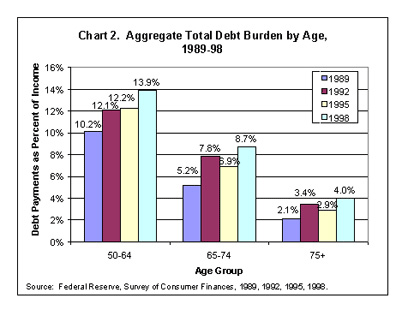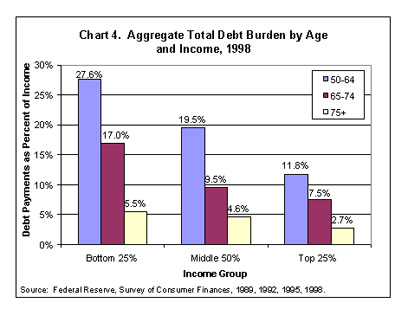Deeper in Debt: Trends Among Midlife and Older Americans
Personal Debt and the Wealth Effect
The latter half of the 1990s may be remembered as a period of unusually strong growth in the American economy, when the nation's wealth grew at a robust 6 percent annual pace, and the three-decade-long string of federal budget deficits was finally reversed. Tax-deferred 401(k) accounts swelled with earnings on stock investments, and by 1998 nearly half the population owned stocks directly or indirectly, up from 32 percent less than a decade earlier.
Little noted at the time, personal debt was accumulating rapidly along with financial assets. Since net worth is the value of assets less all liabilities, and median net worth grew rapidly as well, increases in debt seemed to warrant little concern. The flaw in that thinking was that increases in net worth largely reflected the valuation of assets people held in their 401(k)s and stock options, rather than real savings.
In fact, actual saving out of current income was declining at a precipitous rate. In the latter half of the 1990s, the ratio of net worth to income climbed from about 470 percent to more than 600 percent, while the personal saving rate (income less taxes and consumption) plummeted to zero (Maki and Palumbo, 2001). This pattern reflected what economists have called the "wealth effect", which occurs when people consume more when their paper wealth increases, even though their income may not have increased. When they consume more, without any increase in income, saving necessarily declines. Between 1992 and 2000, aggregate net worth increased from $30 trillion to more than $41 trillion, while the personal saving rate declined by 4.1 percentage points (Maki and Palumbo, 2001; Federal Reserve Board, 2001).
If the wealth effect resulted in increased personal debt during the 1990s, who amassed that debt and how was it distributed? In this Data Digest, we examine changes in debt among families headed by persons aged 50 and older. We examine three income groups—the top quartile, the middle half, and the bottom quartile—and three age groups—50-64, 65-74, and 75 and older, tracing their debt holdings from 1989 to 1998.
Median Debt Amounts since 1989
Between 1989 and 1998, median total debt levels (including housing) for the population aged 50 and older with any amount of debt doubled or nearly doubled at every income level. For those in the bottom quarter of the 50-and-older income distribution, median total debt went from nearly $1,600 to more than $3,500 in 1998 dollars between 1989 and 1998 (see Table 1). For those in the middle half, median debt went from $10,500 to $22,000. For those in the top quartile, it increased from $43,000 to $80,000.
These numbers need to be interpreted with caution, however, for two reasons. First, although about 60 percent of families headed by a person aged 50 or older had some debt, the percentage declined substantially with age. More than three-fourths of those aged 50-64 had some debt, whereas only about half of those aged 65-74 had debt, and only one-quarter of those 75 and older had debt.

Consequently, if we examined all families with a head of household aged 75 and older, rather than just those with outstanding debt, the median (midpoint) debt amount would be zero, because three-fourths of the families have no debt. It would not be much higher for all those aged 65-74, since barely half of them have any debt. So using the total population to determine median debt levels would not be very informative. On the other hand, when we analyze only those families with positive amounts of debt, as in Table 1, we exclude a much larger percentage of people aged 75+ than we do those aged 50-64.
The second reason for caution is that total debt includes mortgage debt, which is different in character from most other debt. Mortgage debt is secured, unlike most other debt, and housing is an asset, so mortgage debt is generally regarded as investment rather than pure consumption. Because housing debt represents a large and growing percentage of total household debt over the period examined (see Chart 1 below), the median nonhousing debt totals for those who have nonzero debt are quite a bit smaller compared with the total debt figures (see Table 1, bottom panel). Table 1 also tells us that nonhousing debt is a much larger share of total debt for people with lower incomes.
Median nonhousing debt, although substantially lower than total debt, shares some patterns with total debt. It tended to increase over the past decade (although not among the top quartile and not two-fold), and it was also lowest among the bottom income quartile and highest among the highest income quartile.
Aggregate Total and Nonhousing Debt Burdens since 1989
While it makes sense that higher-income households carry higher levels of debt because their ability to service it is greater, median debt levels don't tell us anything about families' debt burdens, or what percentage of their income people spend to pay off their debt. While median debt amounts were higher for higher-income people in the 1990s, debt burdens tell a different story.
One way of measuring debt burden is to calculate the ratio of aggregate family debt payments to aggregate family income (Kennickell et al., 2000), called aggregate debt burden. Chart 1 shows the aggregate debt burden ratios over the 1989-98 period for all kinds of debt and for nonhousing debt only.

For the population aged 50 and older, the aggregate total debt burden (including housing) increased from nearly 8 percent to 11.5 percent between 1989 and 1998. When housing debt is excluded, however, a different picture emerges. Whereas total debt burdens increased fairly steadily over the 1989-98 period, nonhousing debt changed little over time (see Chart 1).
Housing debt accounted for the steady increase in total debt burden between 1989 and 1998. The housing debt burden among the population aged 50 and older increased steadily from 2.9 percent of income in 1989 to 6.5 percent in 1998. Housing debt increased as a percentage of total debt from about one-third to more than half for every age group and every income group in the 50 and older population between 1989 and 1998 (data not shown).
Aggregate Debt Burden by Age and Income
In this section we will examine debt burdens among the 50-and-older population, first by age group (50-64, 65-74, and 75+), then by income group (bottom quartile, middle half, and top quartile), and finally by age and income together.
Age. Between 1989 and 1998, aggregate debt burdens increased among families headed by a person aged 50 or older within each age subgroup, rising from 10.2 percent to 13.9 percent for 50-64-year-olds, 5.2 percent to 8.7 percent among 65-74-year-olds, and from 2.1 percent to 4 percent among those aged 75 and older (see Chart 2). As with the medians reported in Table 1, the debt burdens decreased among older age groups, but they increased over time.

Income. Aggregate debt burdens were higher in all three income subgroups in 1998 than they were in 1989 (see Chart 3), following sharp increases between 1995 and 1998 for each income group. The increase between 1989 and 1998 was least pronounced for the lowest income quartile.
Whereas in Table 1 both total and nonhousing debt levels were lowest in the bottom income quartile and highest in the top income quartile, by contrast the debt burden in a given year tended to be highest among the lowest income group (15 percent in 1998) and lowest among the highest income group (10.3 percent for the lowest quartile in 1998).

Age and Income. Combining age and income gives us a more detailed perspective on the patterns of debtholding for people aged 50 and older. Chart 4 shows the three debt burden measures by age and income for a single year, 1998. For any given age group, debt burdens were at least twice as great for the bottom income quartile as the top income quartile. For those aged 50-64 in 1998, the aggregate debt burden was 28 percent in the bottom income quartile and 12 percent in the top income quartile. For those aged 65-74, the aggregate burden went from 17 percent to 9.5 percent to 7.5 percent from lowest to highest income group. For the oldest group, aggregate debt burdens declined from 5.5 percent to 4.6 percent to 2.7 percent from lowest to highest income groups.
Within any income group, debt burdens decreased with increasing age. Aggregate debt burdens are four to five times as large for the youngest age group as for the oldest group at every income level. The highest aggregate debt burden—28 percent—occurred among the 50-64-year-old group in the lowest income quartile.

In sum, debt increased substantially in the late 1990s despite robust growth in net worth, and both total and nonhousing debt burdens decreased as age and income increased. Total debt burdens were highest among low-income pre-retirees.
Footnotes
- The standard measures of national saving—the Commerce Department's National Income and Product Accounts and the Federal Reserve Board's Flow of Funds Accounts—do not treat capital gains, which were a major source of asset revaluation, as saving.
- The percent increased slightly over time in each age group, but the differences among age groups were far greater than the differences over time.
- For the total population, by contrast, aggregate debt burdens rose from 12.7 percent in 1989 to 14.5 percent in 1998 (Kennickell et al., 2000).
- Although they did not increase monotonically over time within income groups.
References
Federal Reserve Board (2001). Flow of Funds Accounts of the United States, Flows and Outstandings, Third Quarter, December 7.
Kennickell, A., et al. (2000). "Recent Changes in U.S. Family Finances: Results from the 1998 Survey of Consumer Finances," Federal Reserve Bulletin, January, pp. 1-29.
Maki, D. and Palumbo, M. (2001). "Disentangling the Wealth Effect: A Cohort Analysis of Household Saving in the 1990s," Federal Reserve Board, Finance and Economics Discussion Series, April. Found at: http://www.federalreserve.gov/pubs/feds/2001/index.html.
Written by John Gist and Carlos Figueiredo, AARP Public Policy Institute
April 2002
©2002 AARP
May be copied only for noncommercial purposes and with attribution; permission required for all other purposes.
Public Policy Institute, AARP, 601 E Street, NW, Washington, DC 20049
